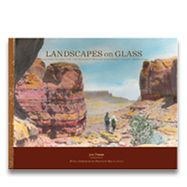

ISBN 978-1-887805-31-5
8.5” x 11” Soft Cover, 127 pages, Color
Price: $19.95
Landscapes on Glass
Lantern Slides for the Rainbow Bridge-Monument Valley Expedition
Jack Turner
with Foreword by President Bill Clinton
The nation was in the throes of the Great Depression when dozens of scientists and students descended on the remote pinnacles and canyons of northern Arizona and southern Utah.
Water interests wanted to dam the canyons; pot hunters wanted to plunder thousand-year-old archaeological sites; cattlemen wanted to graze their livestock; bureaucrats wanted to make it all a living cultural park; and Native Americans just wanted to be left alone.
One man decided to do something for the region. On his own time, and at his own expense, Ansel Hall (then chief naturalist for the National Park Service) organized a massive scientific expedition. For six years, experts from major universities and museums spent summers studying the landscape and its inhabitants, past and present, with the Rainbow Bridge-Monument Valley Expedition.To finance the project, Hall traveled the country, showing lantern slides of the region and soliciting support from philanthropists and foundations.
Landscapes on Glass: Lantern Slides for the Rainbow Bridge-Monument Valley Expedition is the story of what has been called the last great expedition in the American West, and the man who made it happen. Lavishly illustrated with the hand-tinted photographs Hall used in his talks, this book is a tribute to the man, the expedition, and the region they sought to protect.
![]()
From the Denver Post:
You could frame almost any image in Landscapes on Glass and it would hold its own hung alongside other art. It's that singular and splendid.
From the Rocky Mountain Land Library:
Thankfully this book preserves Ansel Hall's story, along with many of the stunning color images.
From the Durango Herald:
The book is a masterwork, and Turner has put together an important piece of historical documentation that is not only fascinating to study and look at, it acts as an historical tour guide into 19th century Southwest America.
![]()

